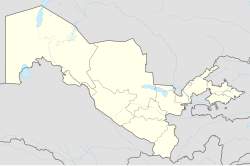Nukus
|
Nukus Нукус |
||
|
karak. : Noʻkis (Нөкис) |
||
|
Art museum in Nukus |
||
| Basic data | ||
|---|---|---|
| State : |
|
|
| Autonomous Republic: |
|
|
| Coordinates : | 42 ° 28 ' N , 59 ° 36' E | |
|
Location of Nukus in Uzbekistan |
||
| Height : | 76 m | |
| Area : | 221 km² | |
| Residents : | 312,100 (2018) | |
| Telephone code : | (+998) 61 | |
| License plate : | 23 | |
Nukus ( Karakalpak No'kis , formerly Cyrillic Нөкис; Russian Нукус ) is the capital of the Autonomous Republic of Karakalpakstan in Uzbekistan with 312,100 inhabitants (at January 1, 2018), on the right bank of the Amu Darya , industrial town (mainly light industry ), the cultural center with the University , pedagogical college and theater .
history
Nukus has been the capital of the Republic of Karakalpakistan since it was founded on April 1, 1932. Nukus was founded because To'rtko'l , the old capital, was unfavorably located and constantly threatened by the floods of the Amu Darya, which is why it was decided to invest the resources in the establishment of a new capital instead of in protective measures around To'rtko'l.
In the 1960s, Nukus was still a flourishing city in the north of Uzbekistan, an oasis in the desert, located on the Aral Sea and on the Amu Darya, which was nicknamed "the rabid" because of its rapid current.
Today the lake has shrunk significantly and the river has become a trickle. In order to get enough water for cotton cultivation , the water of the Amu Darya is diverted into countless channels and no longer reaches the Aral Sea. In 1983 the lake ceased to exist as a fishing area. Dust storms are observed 90 days a year.
Attractions
The Savitzki-Karakalpakstan-Kunstmuseum , named after its former director Igor Vitalievich Savitsky , who "with great effort, courage and enthusiasm" put together a collection of tens of thousands of pictures, houses a unique collection of classic Russian avant-garde art from the 1920s, 1930s and 1940s Years (after that of the Russian Museum in Saint Petersburg, the second largest ever). The remote location of this important collection can be seen as the result of the Stalinist cultural policy, which sent unpleasant artists and their works into exile. Thanks to the foresight of Savitsky and the subordinate geopolitical position of Nukus, the works have been preserved for the interested public.
See main article: Nukus Art Museum
There are also many historical relics to be seen in the area around Nukus, including huge castles (so-called Kalas ).
The Amu Darya seen from the Shilpiq Kala from. (Beginning of May 2019)
climate
In Nukus there is a typical cool desert climate ( BWk ) with a long, very hot and extremely dry summer in which it almost never rains, mild to warm spring and autumn with rare rainfall and a short, but still very cold and sometimes snowy winter.
sons and daughters of the town
- Mansur Valiev (* 1950), Russian Colonel General
- Amandyq Batalow (* 1952), Kazakh politician
- Ädilbek Nijasymbetow (* 1989), Kazakh light heavyweight boxer
See also
Web links
swell
- ↑ Число постоянных жителей в Республике Каракалпакстан на 1 января 2018 года
- ↑ Ibraeva, Valerija: The art of Kazakhstan as a political project. In: Back from the future. Eastern European Cultures in the Age of Post-Communism. Edited by Boris Groys, Anne von der Heiden, Anja Herrmann, Peter Weibel, Julia Warmers. Frankfurt / Main: Suhrkamp, 2006, pp. 407-471, p. 412. ISBN 3-518-12452-8
- ↑ Banned Russian art squirrelled away in Uzbekistan , AlJazeera, May 27, 2015
- ↑ see also: Monika Etspüler: The secret hiding place of the Soviet avant-garde: Avant-garde-oriental divan: One of the most important collections of Russian art can be found in an Uzbek desert town , in: Frankfurter Allgemeine Zeitung, October 21, 2015, page 11 (half-page article about the museum and its head)
- ↑ Louvre in the desert in Die Welt, April 13, 2016, p. 18
- ↑ Валиев Мансур Масгутович , eurasian-defence.ru (Russian)




